Deployment of Temporary Seismic station in Turkana Basin
I was privileged to take part in fieldwork for Turkana Rift Arrays to Investigate Lithospheric Strain (TRAILS) project. The fieldwork involved deployment of temporary seismic stations in the Turkana basin, Kenya.
The seismic stations consist of a seismograph. This is a device for measuring the movement of the earth, and has a ground-motion detection sensor, called a seismometer, coupled with a recording system. It is mostly used to measure seismicity of the earth as well as the interior structure of the earth.
We traveled to Lodwar by road from Nairobi where we experienced some beautiful scenery. When the seismic equipment arrived, we carried out a huddle test. The process involved setting up the subset of station components to collect data overnight. The waveform data was then checked for anomalies before deployment. The aim of the huddle test was to verify if all the station components were working properly after transit and to provide training to us, the student, before fieldwork (Figure 1). The test was educative considering it was my first time setting up a seismograph. Some of the sensors did not unlock using a clie and a break out box (BOB) was used to do this.
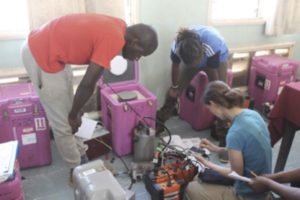
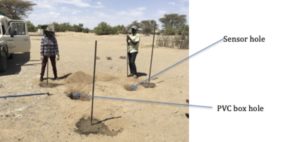
The next step was the seismic station deployment. Permission was given from the county commissioners office and the ministry of education. The stations were located in schools. The first thing we did after arriving at the school was to request permission from the headmasters in the school who were very helpful. An appropriate site was located within the compound. The site should be far away from roads and heavy machinery to avoid cultural noise, have good drainage to avoid flooding, far from trees and power lines to avoid wind generated noise as they sway, easily accessible and have good security to avoid burglary. The second thing we did was to prepare the site. Two holes were dug and an enclosure set up. One hole was dug for the seismometer and the other one for the PVC box that contains some of the station components (Figure 2).
A tile was put in the sensor hole and a bubble level used to check if it was horizontally leveled. The seismometer was then placed on top of the tile. A compass was used to orient the sensor towards the north and leveled until the bubble on the sensor was centered. A PVC box was put in the second hole and a battery, Q330, baler, power box, break out box (BOB) and connecting cables placed inside (Figure 4).Instructions on the installation sheet were followed and the sheet filled. Cables were then connected. The sensor was powered, unlocked and centered using BOB. The sensor function was checked to ensure it was working. In one station we had to replace a seismometer with a spare because it did not unlock. The sensor (covered with a bucket), the box with accessories and trench with connecting cables are buried. The site was then fenced. 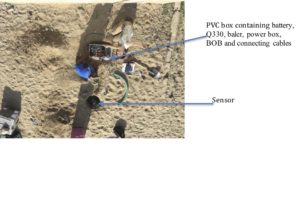
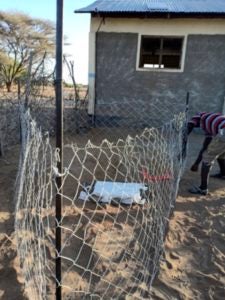
One of the most interesting things about being a geophysicist/seismologist is traveling, meeting people and experiencing different cultures. This fieldwork was no exception. We observed the full moon in a clear sky, passing by lake Turkana, eating Tilapia (once almost cooking it J), the beautiful scenery and the camel traffic (just to name a few) were some of the experiences we had (Figure 6). Accessibility, high temperature, and dust are some of the problems we encountered while in the field. The vehicle got stuck on the sand a few times.
Besides the fieldwork experience, the networking opportunity was great. As a young aspiring seismologist, it was a pleasure meeting and learning from Prof Cindy Ebinger and Dr .Ian Bastow, experienced seismologist who have carried out research in the East African rift system. Further, it was interesting interacting and learning from lecturers from Kenya, fellow students in Kenya and others from the U.S.A and UK. In addition, we met the “future scientist” (primary school students) who were very curious about what we were doing .
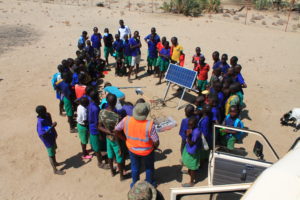

We installed 8 stations on the Lodwar side and 12 more were installed on the Marsabit side. In addition, other stations were deployed in Ethiopia by Ian and his team (Figure 9). The next step will be station servicing and collection of the first set of data. (Photos – Emma, Brandon and Mary enjoying the Turkana region and its gracious people).


